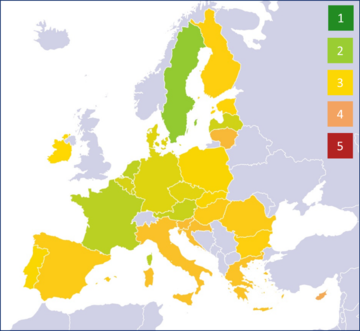Is sustainable finance achievable? This question is increasingly relevant in the new normal following the global crisis and is influenced by the ability of the economic and political context to react. The united, consolidated response to the pandemic, which resulted in the strongest ever fund allocation to support the recovery path, has focused significantly on sustainability and energy transition: in Europe alone, more than €600 billion has been allocated to finance the green transition (representing 30% of the overall Next Generation EU recovery plan's budget earmarked to reach the European Union's Green Deal). The energy crisis, exacerbated by the war in Ukraine, has strongly accelerated this trend, highlighting the need for alternative energy sources.
Sustainability assessments by financial institutions and sustainability certification for companies are the levers to unlocking the benefits that such a transition can deliver.
In Europe, the environmental, social, and governance (ESG) compliance pathway has been strongly promoted by the European Central Bank (ECB) and other European authorities (primarily the European Banking Authority), which require all financial institutions to consider ESG risk within their risk strategy and governance, the evaluation of internal capital requirements, and official capital disclosure.
“Sustainable finance is becoming a 'mandatory opportunity' given the huge funds earmarked by governments and institutions to address the green transition; the global challenges are still ongoing (pandemic and energy crisis) and the ECB’s requirements in Europe have strongly accelerated this pathway,” commented Giorgio Costantino, executive director of CRIF Global Transformation Services.
Banks are expected to provide some specific information on their clients – mainly corporates and small and medium-sized enterprises (SMEs).
To achieve ESG compliance, the ECB also requires clients to provide estimates of direct and indirect GHG emissions (so-called Scope 1, 2 and 3 GHG emissions), the climate risk impacts given a certain climate scenario (so-called physical risk) as a degree of exposure to different natural hazards (flood, landslides, etc), and the financial loss that a company may incur, directly or indirectly, as a result of the transition process toward a low-carbon footprint.
Although many big corporations have already started reporting ESG information through non-financial reporting, most SMEs do not provide (and are not able to provide) information quantifying ESG risks.
The assessment of ESG risk is still at an early stage for the following reasons:
- Shortage of data: Lack of user-friendly, relevant, reliable and comparable data (impact of heat waves, windstorms, hurricanes, tropical cyclones);
- Non-linear effects: ESG risks are often “black swan” events and therefore difficult to assess in terms of all their possible ramifications (e.g. emissions, climate risk, transition risk);
- Uncertainty: The timing and impact of physical and transition risks, social and governance risks are difficult to quantify;
- Multiple impacts: ESG risks can simultaneously affect credit risk, market risk, capital and liquidity adequacy.
ESG compliance can only be unlocked through a solid ESG dataset, a proven methodology to ensure a qualitative and quantitative ESG assessment (i.e. an ESG Score), and solid platforms and technology to enable ESG usage by banks and companies.
“Advanced analytics, information and proven methodologies, will play a crucial role in supporting financial institutions in assessing the ESG compliance of their clients and companies requiring certification. CRIF has leveraged its information network and strong risk management capabilities to create an ESG data lake, a proven advanced analytics methodology to address ECB expectations (mainly physical risks and GHG emissions), and technology platforms to support ESG compliance certification and assessment.”
Since 2018, CRIF has been investing in the development of a unique ESG Framework to unlock the ESG assessments of financial institutions and ESG certification of companies. The Framework comprises three main components: ESG data lake, ESG scores and advanced analytics methodology, and ESG platforms and APIs. The unique ESG data lake comprising more than 140 KPIs in line with the EU taxonomy and EBA requirements; the data lake leverages single-name business information from the whole CRIF Group dataset, combined with other data from all other available datasets (e.g. EUROSTAT, European Commission, European Environment Agency, Copernicus, European Space Agency, etc).
The result is a synthetic assessment (ESG score) which, as a comprehensive single-name assessment of environmental social and governance factors, provides the most valuable insights to inform the transition pathway.
Secondly, a proven advanced analytics set of KPIs has been developed to address ECB requirements, combining a proven methodology (often with the support of trusted partners) and its business information network to provide a single-name assessment regarding the following aspects:
- Solid estimation of a company’s greenhouse gasses, combining the industry GHG target with the business characteristics of each company (e.g. size according to turnover, number of employees);
- Strong evaluation of the company’s climate and physical risk through the estimation of the probability of occurrence of natural events at a micro-territorial level (e.g. coastal flooding with a spatial resolution of 25m) and the company’s vulnerability to each natural event, based on the characteristics of the industry in which each company operates;
- A final combination of the above results, weighting and evaluating the level of investment required to mitigate the level of emissions (and reach the target) and the impact of physical risks.
Thanks to its internal dataset (business information, asset localisation), the ESG score and KPIs are available for all EU27 countries. Figure 1 shows an initial exercise carried out to apply the ESG risk score and rating to a sample of companies in each European country.
Figure 1: Average ESG Score for each EU27 country (based on a representative sample of companies)
Combining the above quantitative KPIs with the information directly retrieved from the companies and a set of API enabled banks to rapidly evaluate the level of ESG compliance of their client portfolio. This is available through "Synesgy" CRIF’s unique industry-driven platform.





